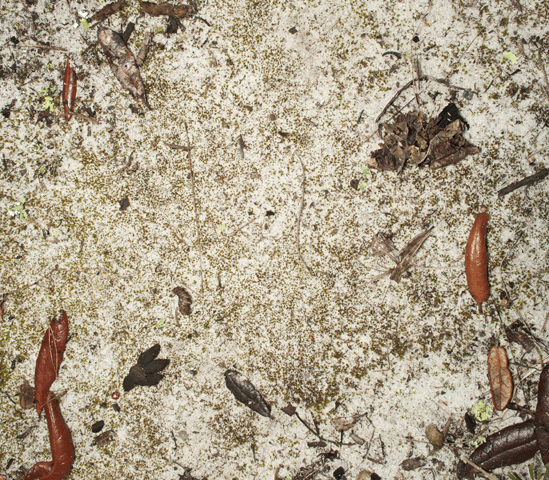Chlorophytes (Algae) in the Christopher B. Smith Preserve
Chlorophyte Characteristics: This phylum/division includes green algae. Chlorophyll, a green pigment, gives green algae its color. Chlorophyll is the substance that absorbs sunlight and uses that energy for the chemical reaction that synthesizes carbohydrates from carbon dioxide and water.
Various species of algae are unicellular, multicellular, and colonial. Species use a variety of asexual and sexual reproductive techniques. Most green algal species are aquatic or marine, but some are terrestrial. The terrestrial species live on moist soil or rocks, or on the trunks of trees. Although there are a variety of algal species living in the filter marsh, it is the terrestrial forms that have been photographed and described.
Interactions in the Smith Preserve: Like other plants, algae convert energy of sunlight to energy other organisms can use. The conversion process is photosynthesis and the energy is distributed to animals through the food web. Also during photosynthesis, chlorophytes produce oxygen. In addition, chlorophytes provide habitat for other organisms and some live in symbiotic relationships with fungal cells to form lichens. Click to learn more about lichens.
Phylum |
Family |
Species Name |
Common Name |
Chlorophyta |
Unknown |
Unknown |
|
Chlorophyta |
Trentephliaceae |
Trentepohlia sp |
Unknown Species Unknown Common Name
Much of the sand in the Smith Preserve scrub is covered by a thin crustal community of highly specialized micro and macro organisms. When dry, some of these crusts are black. After rain or heavy dew, a green color becomes visible as shown in this photograph. The green color may be caused by one or more species of alga. Each alga is very small. For scale, look at their size compared to the size of the five cm long leaves in this photograph. The leaves are Quercus geminata (Sand Live Oak). Click here to learn more about the Smith Preserve biological soil crusts.
|
Trentepohlia sp. No Common Name
|

